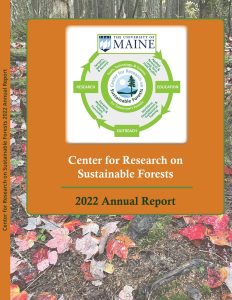Annual Reports
 2022 Annual Report (pdf)
2022 Annual Report (pdf)
Edited by Aaron Weiskittel & Meg Fergusson
Highlights of 2022
-
-
-
-
-
-
- Four-year Center review completed in early 2022 highlights how CRSF has grown significantly in its capacity and overall impact on multiple fronts, including research, outreach, and education. The report summarizes its successes and challenges to enhance our understanding of Maine’s forest resources in an increasingly complex world.
- Natural Climate Solutions analysis and findings for forest and agriculture practices final report and fact sheets published.
Season 2 of the Forest Climate Change Science & Practice coupled lunch hour webinars with in-person field tours at Holt Research Forest, Schoodic Peninsula, Rangeley Lakes region, and Penobscot Experimental Forest. - “Developing Priorities for Eastern White Pine Health and Management” symposium held in March 2022.Topics included white pine health issues, management of EWP in natural systems, and management of EWP at the rural/urban interface.
- Over the last 25 years Howland Forest has stored almost 3.5 tons of CO2 per acre each year, even though that timespan has included the warmest, wettest, and driest years in the last 125. Although the Howland Forest is maturing, it is storing on average a bit more carbon each year. Over the past year, three graduate and two undergraduate students gained training at Howland.
- Our online web mapping system (ForEST) was substantially restructured and the code base modernized to improve operability and stability. This project has prioritizes recruiting recent CS graduates as lead programmers with supportive mentoring by senior personnel.
-
-
-
-
-
Project progress and final reports by CRSF researchers cover: carbon sequestration; the influence of forest management practices on soil productivity, carbon storage and conservation; lowland northern white-cedar ecology & management; Intelligent GeoSolutions project objectives & outcomes; Penobscot Experimental Forest and Howland Research Forest research updates; forest carbon research; resilience indicators to ensure equitable, objective, & continued investment in Northern Border Communities; greenhouse mitigation potential of natural climate solutions from Maine’s working lands; landscape planning and adaptation in anticipation of a regional insect outbreak; understanding climate changes risks & behavior; Forest carbon estimation via LiDAR; eastern white pine resilience.
Be sure to regularly check our News & Events page so you’ll know about future publications and events.
Past Reports
